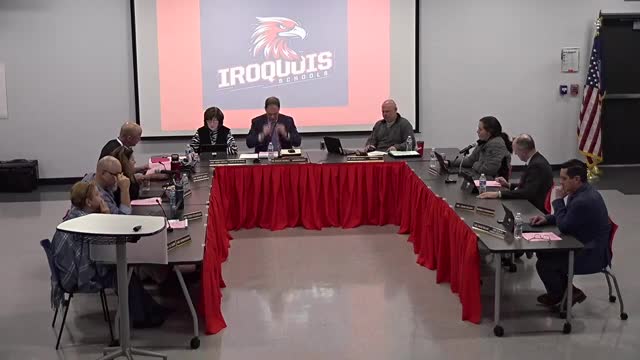Board supports student representative plan; work session to draft policy
January 11, 2025 | IROQUOIS CENTRAL SCHOOL DISTRICT, School Districts, New York
This article was created by AI summarizing key points discussed. AI makes mistakes, so for full details and context, please refer to the video of the full meeting. Please report any errors so we can fix them. Report an error »

Board members and student-cabinet representatives discussed a plan to add a student member of the board. Administration summarized responses from about a dozen nearby school districts: approaches vary, with some boards appointing or receiving recommendations, others using student-government elections.
District student leaders told the superintendent they want a participating representative (not a token appointment), teacher recommendations to reduce popularity-contest selection risk, and a selection process that includes public meetings and a student vote. The superintendent proposed a combined approach: interested students sign up, receive teacher recommendations, attend a board meeting to demonstrate commitment, then the student body votes; the highest vote-getter would serve as the student representative.
Board members said administration should not unilaterally pick the student member and favored a student vote with staff recommendations and a verification interview. The board asked administration to prepare a formal policy and hold a work session with the district’s policy service and NISBA guidance; staff said the policy would be ready in time for a July 1, 2025 start and that elections would align with existing student government timelines.
Why it matters: A student representative gives a voice to the student body and requires policy clarity on expectations, term, confidentiality and attendance.
Next steps: Administration will schedule a work session to draft a student-representative policy with the board, consult policy services, and plan a spring election so the representative can take office July 1, 2025.
District student leaders told the superintendent they want a participating representative (not a token appointment), teacher recommendations to reduce popularity-contest selection risk, and a selection process that includes public meetings and a student vote. The superintendent proposed a combined approach: interested students sign up, receive teacher recommendations, attend a board meeting to demonstrate commitment, then the student body votes; the highest vote-getter would serve as the student representative.
Board members said administration should not unilaterally pick the student member and favored a student vote with staff recommendations and a verification interview. The board asked administration to prepare a formal policy and hold a work session with the district’s policy service and NISBA guidance; staff said the policy would be ready in time for a July 1, 2025 start and that elections would align with existing student government timelines.
Why it matters: A student representative gives a voice to the student body and requires policy clarity on expectations, term, confidentiality and attendance.
Next steps: Administration will schedule a work session to draft a student-representative policy with the board, consult policy services, and plan a spring election so the representative can take office July 1, 2025.
Don't Miss a Word: See the Full Meeting!
Go beyond summaries. Unlock every video, transcript, and key insight with a Founder Membership.
✓
Get instant access to full meeting videos
✓
Search and clip any phrase from complete transcripts
✓
Receive AI-powered summaries & custom alerts
✓
Enjoy lifetime, unrestricted access to government data
30-day money-back guarantee

